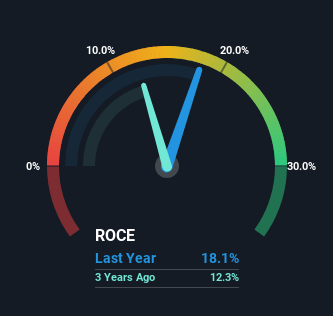Salona Cotspin (NSE:SALONA) Has Some Way To Go To Become A Multi-Bagger
If you're looking for a multi-bagger, there's a few things to keep an eye out for. Firstly, we'd want to identify a growing return on capital employed (ROCE) and then alongside that, an ever-increasing base of capital employed. This shows us that it's a compounding machine, able to continually reinvest its earnings back into the business and generate higher returns. With that in mind, the ROCE of Salona Cotspin (NSE:SALONA) looks decent, right now, so lets see what the trend of returns can tell us.
Return On Capital Employed (ROCE): What Is It?
For those who don't know, ROCE is a measure of a company's yearly pre-tax profit (its return), relative to the capital employed in the business. The formula for this calculation on Salona Cotspin is:
Return on Capital Employed = Earnings Before Interest and Tax (EBIT) ÷ (Total Assets - Current Liabilities)
0.18 = ₹229m ÷ (₹3.0b - ₹1.7b) (Based on the trailing twelve months to September 2023).
Thus, Salona Cotspin has an ROCE of 18%. On its own, that's a standard return, however it's much better than the 10% generated by the Luxury industry.
See our latest analysis for Salona Cotspin

While the past is not representative of the future, it can be helpful to know how a company has performed historically, which is why we have this chart above. If you want to delve into the historical earnings, revenue and cash flow of Salona Cotspin, check out these free graphs here.
What The Trend Of ROCE Can Tell Us
While the current returns on capital are decent, they haven't changed much. The company has consistently earned 18% for the last five years, and the capital employed within the business has risen 196% in that time. 18% is a pretty standard return, and it provides some comfort knowing that Salona Cotspin has consistently earned this amount. Over long periods of time, returns like these might not be too exciting, but with consistency they can pay off in terms of share price returns.
On another note, while the change in ROCE trend might not scream for attention, it's interesting that the current liabilities have actually gone up over the last five years. This is intriguing because if current liabilities hadn't increased to 57% of total assets, this reported ROCE would probably be less than18% because total capital employed would be higher.The 18% ROCE could be even lower if current liabilities weren't 57% of total assets, because the the formula would show a larger base of total capital employed. So with current liabilities at such high levels, this effectively means the likes of suppliers or short-term creditors are funding a meaningful part of the business, which in some instances can bring some risks.
What We Can Learn From Salona Cotspin's ROCE
The main thing to remember is that Salona Cotspin has proven its ability to continually reinvest at respectable rates of return. And the stock has done incredibly well with a 450% return over the last five years, so long term investors are no doubt ecstatic with that result. So even though the stock might be more "expensive" than it was before, we think the strong fundamentals warrant this stock for further research.
Salona Cotspin does have some risks, we noticed 5 warning signs (and 2 which are a bit unpleasant) we think you should know about.
For those who like to invest in solid companies, check out this free list of companies with solid balance sheets and high returns on equity.
New: Manage All Your Stock Portfolios in One Place
We've created the ultimate portfolio companion for stock investors, and it's free.
• Connect an unlimited number of Portfolios and see your total in one currency
• Be alerted to new Warning Signs or Risks via email or mobile
• Track the Fair Value of your stocks
Have feedback on this article? Concerned about the content? Get in touch with us directly. Alternatively, email editorial-team (at) simplywallst.com.
This article by Simply Wall St is general in nature. We provide commentary based on historical data and analyst forecasts only using an unbiased methodology and our articles are not intended to be financial advice. It does not constitute a recommendation to buy or sell any stock, and does not take account of your objectives, or your financial situation. We aim to bring you long-term focused analysis driven by fundamental data. Note that our analysis may not factor in the latest price-sensitive company announcements or qualitative material. Simply Wall St has no position in any stocks mentioned.
About NSEI:SALONA
Salona Cotspin
Engages in the manufacture and sale of cotton yarn, knitted fabrics, and garments in India and internationally.
Moderate risk with mediocre balance sheet.
Similar Companies
Market Insights
Community Narratives



